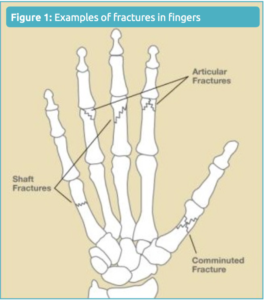Price: $8,000.00
CPT Code: 26746
Broken Hand (Hand Fracture)
 The bones of the hand serve as a framework. This framework supports the muscles that make the wrist and fingers move. When one of these hand bones is broken (fractured), it can prevent you from using the hand, wrist and fingers.
The bones of the hand serve as a framework. This framework supports the muscles that make the wrist and fingers move. When one of these hand bones is broken (fractured), it can prevent you from using the hand, wrist and fingers.
Many people think that a fracture is different from a break, but they are the same (see Figure 1). There can be different variations of a fracture, including:
• Stable fracture, when the bone pieces are aligned
• Unstable fracture, when there are bone fragments that have shifted
• Comminuted fracture, when the bone is shattered into many pieces
• Open (compound) fracture, when a bone fragment breaks through the skin. This causes risk of infection.
Signs and Symptoms
Symptoms of a broken hand can include:
• Pain and stiffness
• Difficulty moving the hand, wrist and/or fingers
• Deformities such as a crooked finger (this is less likely)
Treatment
Medical evaluation and x-rays are usually needed for your doctor to diagnose the fracture and determine the treatment. Depending on the type of fracture, your hand surgeon may recommend one of several treatment methods.
A splint or cast may be used to treat a stable fracture some unstable fractures, in which the bone has moved, may need to be set and then held in place with wires or pins. This is done without surgery. More serious fractures may need surgery to set the bone and hold the bone fragments together with pins, plates or screws.
Sometimes, bone may be missing or be so severely crushed that it cannot be repaired. In such cases,
a bone graft may be necessary. In this procedure, bone is taken from another part of the body.
Recovery
Sometimes, a bony lump may appear at the spot of the broken bone during recovery known as a “fracture callus.” This is normal, and the lump usually gets smaller over time. Some problems you may have while your fracture is healing include:
• Stiffness
• Shifting of bone
• Infection
• Slow healing
To increase your chances of a healthy recovery, do not smoke, and carefully follow your doctor’s instructions. Your doctor may recommend hand therapy to improve the process. It is important to note that not all fractures completely heal. Because bones have such a close relationship with ligaments and tendons, the hand may be stiff and weak even after the healing process. Some fractures may lead to arthritis down the road. In addition, fractures in children occasionally a ect future growth of that bone.
© 2016 American Society for Surgery of the Hand
